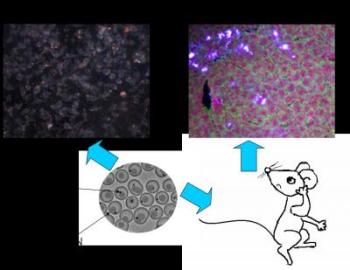Apr 30 2013
In recent years, metal nanoparticles have showed great application prospect in the field of biological imaging, cancer diagnosis and treatment due to its unique optical scattering and optical absorption properties.
 SN @ GNs showed dark-field imaging function of cell and animal tissue and significantly improved the biocompatibility of gold nanoparticles. Credit: ©Science China Press
SN @ GNs showed dark-field imaging function of cell and animal tissue and significantly improved the biocompatibility of gold nanoparticles. Credit: ©Science China Press
In many metal materials, gold nanoparticles have caused concerns in the field because of its simple preparation, easy to modify advantages. However, the poor stability in physiological fluids environment and the potential toxicity of gold nanoparticles always restricts its application in the biological field.
TANG Fangqiong and her group from Laboratory of Controllable Preparation and Application of Nanomaterials, Technical Institute of Physics and Chemistry, Chinese Academy of Sciences have been devoted to the controllable preparation of nanomaterials and biological applications. In recent years, they invented a method to fabricate silica nanoparticles with the special rattles-type structure named silica nanorattles (SNs) and developed the nanoparticles as drug delivery system, biological detection and catalytic. Their work, entitled "Dark field imaging of rattle-type silica nanorattles coated gold nanoparticles in vitro and in vivo", was published in Chinese Science Bulletin 2013, Vol 58(7).
In this paper, the gold nanoparticles were ingeniously hybridized into the hollow cavity of silica nanorattles. Then, a new type silica nanorattles coated gold nanoparticles (Silica nanorattles @ gold nanoparticles, SN @ GNs) was obtained. It has advantage as following, scale preparation, good stability in the physiological environment and reduce gold nanoparticles agglomeration. These particles remained the strong optical scattering of gold nanoparticles and plasma resonance properties which can be used in dark field imaging of cells and animal tissues in vivo (figure 1). And more important is the silica nanoshells significantly reduced the toxicity of gold nanoparticles in vivo, which increase the maximum tolerated dose to 200 mg/kg.
Above all, TANG group have developed a new type of composite nanoparticles combination of silica good biocompatibility and the optical properties of gold nanoparticles. It provides a new material and method for the application of nanomaterials in biological imaging and disease diagnosis. This research project was partially supported by a grant from the National High Technology Research and Development Program (2011 AA02A114) and the National Natural Science Foundation of China (61178035, 61178035 and 61171049).